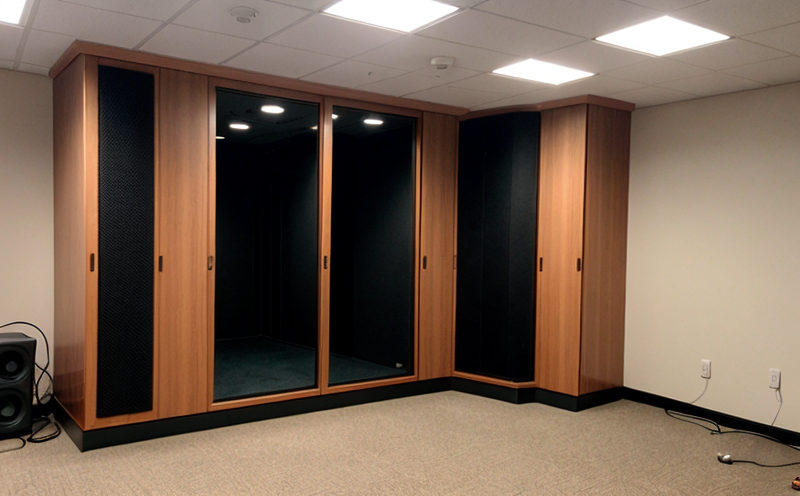IEC 60565 Hydrophone Calibration for Underwater Acoustics
The calibration of hydrophones according to IEC 60565 ensures that measurements in underwater acoustics are accurate and reliable. This standard is crucial for quality managers, compliance officers, R&D engineers, and procurement teams who need precise data for their acoustic testing requirements.
Hydrophones are essential sensors used in the field of underwater acoustics to measure sound pressure levels. They play a significant role in various applications such as sonar systems, environmental monitoring, and naval communications. The accuracy of these measurements is paramount, especially when dealing with sensitive data that can affect decision-making processes.
The IEC 60565 standard provides specific guidelines on how to calibrate hydrophones, ensuring they meet the required standards for performance in underwater environments. Calibration involves a series of steps aimed at validating the sensor's ability to accurately measure sound pressure levels within its specified frequency range and sensitivity.
The process typically begins with selecting an appropriate calibration setup that includes reference transducers and calibration fluids. The hydrophone is then immersed in this setup under controlled conditions, allowing for precise measurement comparisons. This step ensures that any discrepancies between the actual and expected values are minimized.
Once calibrated, it's essential to verify the performance of the hydrophones through rigorous testing protocols. These tests may include exposing the devices to various sound pressure levels and frequencies, observing their responses, and comparing these against known reference standards.
The results from these calibrations are critical for ensuring compliance with international regulations and industry best practices. For instance, organizations involved in military applications must adhere to strict guidelines set forth by NATO or other relevant bodies. Similarly, environmental agencies rely on accurate hydrophone data when assessing water quality and marine life.
In addition to meeting regulatory requirements, accurately calibrated hydrophones also contribute significantly to product development cycles. By providing reliable baseline measurements during the early stages of design iterations, engineers can identify potential issues more quickly and make informed adjustments before proceeding further into production phases.
Moreover, consistent calibration practices help maintain trust between manufacturers and customers by demonstrating a commitment to quality throughout the supply chain. This aspect is particularly important in sectors where safety and performance are paramount, such as aerospace or automotive manufacturing.
To summarize, IEC 60565 hydrophone calibration serves multiple purposes including ensuring compliance with international standards, enhancing product reliability, supporting research and development efforts, and fostering industry collaboration. By adhering to this standard, laboratories can deliver high-quality services that meet the needs of diverse stakeholders across different sectors.
Applied Standards
The IEC 60565 calibration process for hydrophones is based on internationally recognized standards which include:
- IEC 60565:1998 – Acoustic measurement microphones and hydrophones
- ISO/IEC 80408-3:2017 – Electroacoustics – Microphone and hydrophone measurements – Part 3: Hydrophone calibration procedures
The latest revision of IEC 60565 provides updated methodologies for calibrating both pressure and particle velocity hydrophones, emphasizing the importance of traceability to primary standards. Compliance with these standards ensures that all calibration activities are conducted consistently across different laboratories worldwide.
Benefits
Accurate hydrophone calibration offers numerous advantages for organizations operating in various industries:
- Enhanced Accuracy: Ensures that all measurements are precise, reducing errors and discrepancies.
- Compliance Assurance: Helps meet regulatory requirements set by governing bodies like NATO or EPA.
- Improved Product Quality: Supports better product design and quality assurance processes during R&D stages.
- Better Decision-Making: Provides reliable data for informed business decisions, leading to improved operational efficiency.
- Increased Customer Trust: Demonstrates a commitment to maintaining high-quality products throughout the supply chain.
- Environmental Sustainability: Accurate hydrophone calibration contributes towards sustainable practices by improving resource utilization and minimizing waste.
- Innovation Facilitation: Enables continuous improvement in technology development, fostering innovation within organizations.
Quality and Reliability Assurance
Our laboratory adheres to strict quality control measures during every stage of the IEC 60565 hydrophone calibration process:
- Calibration Setup Verification: Ensures that all components used in the calibration setup are functioning correctly.
- Data Recording: Maintains meticulous records of all measurement data for future reference and audits.
- Validation Checks: Performs additional checks to confirm that the results fall within acceptable tolerances as per IEC 60565 specifications.
We employ state-of-the-art equipment and highly skilled technicians who are trained specifically in performing hydrophone calibrations according to this international standard. Our commitment to excellence guarantees that each calibration meets or exceeds the required standards.





